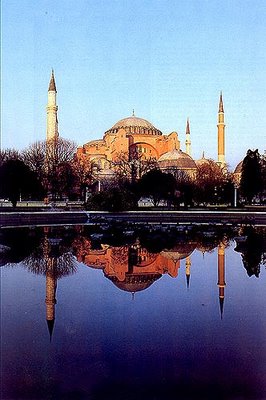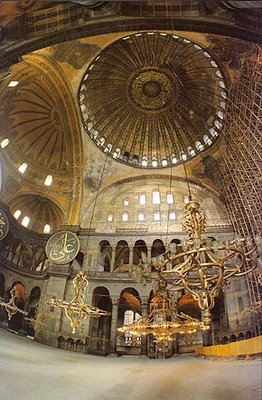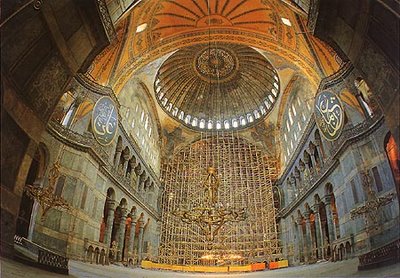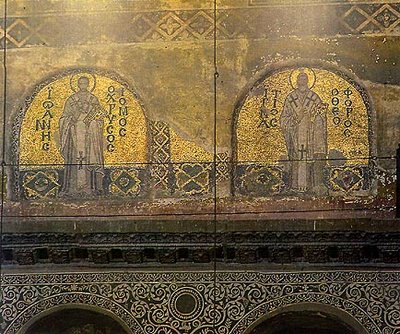I have been reliably informed that this

did not arrive in the mail today.
Let's get cracking, people. It's not like I'm asking for naked pictures of Bea Arthur or something difficult like that.
A middle-aged husband, father, bibliophile and history enthusiast commenting to no one in particular.

Another view:

From the East:

And then there is the interior:


Now for the frescoes:

This one is a closeup of the above, and depicts Justinian (left) presenting Hagia Sophia to the Infant Christ and the Virgin, and Constantine (right) presenting Constantinople to them.

Christ Pantocrator:
 Next is a depiction of the Emperor John II Komnenos (Comnenus) (reigned 1118-1143) and his wife, the Empress Irene. John was beloved by his subjects and called "the Good." He never had anyone tortured or mutilated during his reign, which included a coup attempt at its very beginning by his elder sister, Anna (the famous historian and author of The Alexiad). It is suspected that Anna's reluctant husband, Nikephoros Bryennios, who was expected to be emperor if the plot succeeded, warned John. By the standards of the time, he was very lenient, merely sending the plotters off to a semi-comfortable banishment and confiscating their property. Moreover, he enjoyed several military successes, pushing back the Seljuk Turks and recovering territory lost to the Turks during the previous century. He and his wife also founded a large modern hospital for the poor in Constantinople:
Next is a depiction of the Emperor John II Komnenos (Comnenus) (reigned 1118-1143) and his wife, the Empress Irene. John was beloved by his subjects and called "the Good." He never had anyone tortured or mutilated during his reign, which included a coup attempt at its very beginning by his elder sister, Anna (the famous historian and author of The Alexiad). It is suspected that Anna's reluctant husband, Nikephoros Bryennios, who was expected to be emperor if the plot succeeded, warned John. By the standards of the time, he was very lenient, merely sending the plotters off to a semi-comfortable banishment and confiscating their property. Moreover, he enjoyed several military successes, pushing back the Seljuk Turks and recovering territory lost to the Turks during the previous century. He and his wife also founded a large modern hospital for the poor in Constantinople:
 Sts. John Chrysostom and Ignatius of Antioch, respectively:
Sts. John Chrysostom and Ignatius of Antioch, respectively:

More incurable Byzantinophilia to come. [All links except the first via the magnificent website of the Ecumenical Patriarchate of Constantinople.]
I don't know precisely when--or why--I got bit by the Byzantium bug. It was sometime in high school, though, and right after I went through my Ave Constantine Imperator! fascination with all things Roman phase.
I suspect it was out of sheer joy that the saga of Rome had not ended with its collapse under barbarian assault, and now I would have even more to read. You know, there are times when I can actually hear Heather cringing from miles away. My high school friends may recall--with head-shaking, no doubt--me lugging obscure dust-covered tomes from the Alma College library, right down to one of the imperial treatises of Constantine VII Porphyrogenitus.
What's that? "How many times did I go on dates in high school?" Um, 5 or so. Maybe less. Why do you ask?
The good of it was that the obsession (call it what it is) culminated in a trip to the Island of Torcello, and the remarkable Church of Santa Maria Assunta. Santa Maria still has its cornerstone from 632, when the Byzantines built it.
All of that is a prologue to say that I will be periodically posting bits about my fascination with this much-neglected part of history as time permits over the next several months, including book recommendations and the like. Here's a good start, though--a fairly-decent Wikipedia article about the history of the empire, a list of assorted primary and secondary source links, and a link to the incomparable art of Byzantium.
Now, the idea that Mr. Brown's mother could suck-start a leafblower will prove controversial, and no doubt the Browns might possibly take offense. However, (1) it's just fiction, and (2) DT was a revolutionary film with a resonating impact on culture, which continues to echo in the so-called "culture wars" of today, making these important ideas worth discussing. It is safe to say that the discussion generated will be fascinating, as will be the input of scholars of both print and film.
I look forward to your response.
Very truly yours,
Dale Black [pen name]

Yep, the mural even has the priest raising the crucifix as the Poles send Tukhachevsky's Red hordes into pell-mell retreat. Apparently, it wasn't quite triumphant enough for the exultant parishoners, who prevailed upon the artist to make it obvious that the Polish biplane was strafing the Russians.
I'll see you your Santiago Matamoros, and raise you the Miracle at the Vistula. Make sure you stop by to see St. Josaphat when you are in town.
The interior of Saint Paul Melkite Greek Catholic Church, Harissa, Lebanon. I have decided to set up a Substack exploring Eastern Christi...
